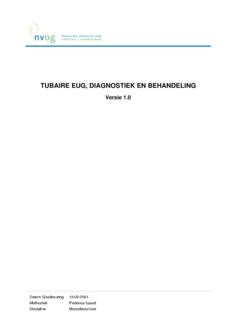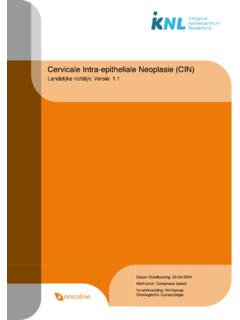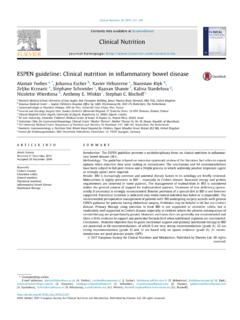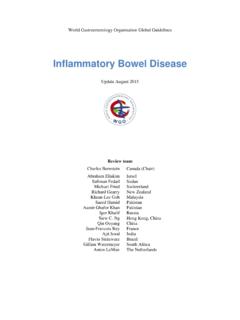Transcription of SECTION 3 CHAPTER 18 Disease and Ulcerative Colitis
1 IntroductionUlcerative Colitis (UC) and Crohn s Disease (CD) arechronic inflammatory bowel diseases of unknown , both conditions usually begin gradually, butthey can start abruptly and sometimes even present asfulminant clinical course is characterized byexacerbations and spontaneous or drug-induced remis-sions. UC primarily affects the mucosa of the largebowel, while CD is a transmural Disease that can affectthe whole gastrointestinal tract. The various clinical pat-terns are reflected in the microscopic features observedin biopsies obtained from surgical specimens or duringendoscopy. Endoscopic mucosal biopsies will not showall the characteristic features of CD. Review of biopsies,in combination with clinical, laboratory, radiographicand endoscopic observations, is used for the diagnosis ofUC and CD and the differentiation from other condi-tions.
2 Such differentiation is important because a precisediagnosis is essential for appropriate 3 Acorrect diagnosis is possible in the large majority ofpatients; still, in some patients with acute onset or fulmi-nant Disease , a precise diagnosis may be difficult to reach,resulting in a temporary diagnosis of indeterminatecolitis (IC). Biopsies also allow assessment of diseaseactivity and identification of pre-cancerous lesions andcancer. In clinical practice, often only rectal biopsies areobtained for diagnosis. However, in contrast with UC,the rectum is not always involved in CD and lesions in CD frequently occur in a background of it is more appropriate to take multipleendoscopic biopsies in different segments of the colon(and ileum) during the initial work-up of a patient pre-senting with inflammatory diarrhea or during follow-upand screening for cancer.
3 Multiple biopsies permit an in-depth analysis of the distribution of inflammation andare essential for the recognition of dysplasia. It also255 SECTION 3 CHAPTER18 Histopathology of Crohn sDisease and Ulcerative ColitisK. GEBOESGoalTo review the important histologic features required for thediagnosis, assessment of Disease activity and earlydetection of malignancy. The variability of features withtime and treatment and difficult differential diagnosticproblems will be discussed. Key points Histopathology can help to solve many diagnosticproblems, especially when multiple biopsies of the colonand ileum are available. Exacerbations and remissions are reflected by mucosalinflammation and activity of variable intensity, includinghealing. Multiple biopsies are also indicated for the earlydetection of pre-cancerous lesions and cancer inulcerative Colitis and Crohn s references Schumacher G, Kollberg B, Sandstedt B.
4 A prospectivestudy of first attacks of inflammatory bowel Disease andinfectious Colitis . Histologic course during the 1st yearafter presentation. Scand J Gastroenterol1994;29:318 332. Jenkins D, Balsitis M, Gallivan S et al. Guidelines for theinitial biopsy diagnosis of suspected chronic idiopathicinflammatory bowel Disease . The British Society ofGastroenterology Initiative. J Clin Pathol1997; 50:93 105. Shepherd NA. Pathological mimics of chronicinflammatory bowel Disease . J Clin Pathol1991;44:726 733 SECTION 3 IBD4E-18(255-276) 03/04/2003 10:32 AM Page 255increases diagnostic accuracy by 5 41%. Carcinoma can occur during the course of the Disease as a late Normal IntestineThe gastrointestinal (GI) tract is a hollow tube consistingof three layers: mucosa, submucosa, muscularis propriaand loose areolar tissue covered by mesothelium wherethe tract borders on the body cavity (serosa).
5 In thecolon, the surface of the mucosa is flat and its architec-ture is characteristic with crypts as straight tubes, in par-allel alignment. The crypt base rests upon a layer ofsmooth muscle cells, the muscularis mucosae, whichseparates the mucosa from the submucosal connectivetissue. The distance between the crypts and the internaldiameter of the crypts is crypt architectureis maintained throughout the colon, except in the pres-ence of lymphoid collections, in zones of transition tosmall intestinal mucosa (ileocecal valve) or to squamousepithelium (the anorectum) and in normally occurringgrooves in the surface. In the small intestine, the surfaceis irregular due to the presence of finger-like villi ofuniform size and shape. In the ileum, the villi are tallerand the crypts less deep compared with the , villi and crypts are covered with a single-celllayer of columnar epithelium, separated from the con-nective tissue lamina propria by the basement membranecomplex.
6 The epithelial cells form a heterogeneousgroup with mature cells (absorptive enterocytes andgoblet cells) lining the surface, villi and upper part of thecrypts, immature crypt cells including stem cells in thebase of the crypts and endocrine cells. Paneth cells arepresent in the base of the crypts in the small intestineand caecum. Epithelial cells have a barrier and secretoryfunction and are involved in the immune response(secretion of SIgA). In the colon they do not constitu-tively express the major histocompatibility class II anti-gens (MHC). Epithelial cell turnover ranges between 2and 8 6 The lamina propria extends from the subepithelialbasement membrane complex to the muscularismucosae. It is composed of extracellular matrix, fibro-blasts and various types of leukocytes.
7 The presence ofleukocytes is necessary because the mucosa is continu-ously challenged by luminal antigens, which results in a controlled or physiologic inflammation. Lymphocytesare the largest subtype. According to the location, theyare subdivided into intraepithelial lymphocytes (IEL),lamina propria lymphocytes (LPL) and lymphocytesorganized in follicles in association with epithelial cells(lymphoepithelial complexes). The latter may extendacross the muscularis mucosae (Fig. ). They consti-tute the mucosa associated lymphoid tissue (MALT)where the immune response is induced. GALT (gutassociated lymphoid tissue) is especially prominent inthe appendix and terminal ileum where it forms thePeyer s patches along the anti-mesenteric border.
8 Fourcompartments are distinguished in Peyer s patches: thefollicle, dome, follicle-associated epithelium and inter-follicular regions. The specialized follicle-associatedepithelium, overlying lymphoid aggregates is distinctfrom the surrounding villous epithelial surfaces. Itcharacteristically has fewer goblet cells and containsmembranous cells or M M cell is a specializedepithelial cell that transports luminal antigens, thusallowing access to immunocompetent cells. It plays akey role in mucosal-based immunity and antigen toler-ance. IELs are present in-between the epithelial cellslining the surface. They are mainly CD8+T lympho-cytes. LPLs are B cells (15 40%) and T cells (40 90%)and a limited number of natural killer cells.
9 B cells aremainly present as plasma cells with a predominance ofIgA over IgM and IgG containing majority ofthe T cells are CD4+cells (65%). A second importantsubtype of leukocytes in the lamina propria are the cellsof the monocyte/macrophage lineage. In the colon theyare diffusely present in the subepithelial part of thelamina propria. They are a heterogeneous group com-posed of cells having more phagocytic properties andcells equipped for antigen presentation. They appearoften as foamy ,8 Other myeloid cells thatnormally reside in the lamina propria are eosinophilsand mast cells. Neutrophils should not be are located randomly, distributed throughoutthe lamina propria and in the most superficial portionand the pericryptal fibroblast sheet, tightly apposed tothe subepithelial basement membrane , OF CROHN S Disease AND Ulcerative COLITISSECTION 3.
10 DIAGNOSIS: A CLINICIAN S PERSPECTIVE256 Fig. colon. Mucosal lymphoid follicle extendingtowards the submucosa. The germinal centre is stimulated (H&E 25).IBD4E-18(255-276) 03/04/2003 10:32 AM Page 256An adequate immune response implies migration ofimmune cells, cell recognition and interaction of cellsrequiring adhesion and deadhesion. Proteins involved inleukocyte recruitment and migration belonging to thelarge family of adhesion molecules are therefore vari-ably expressed on endothelial cells and involved in cell interactions can also beidentified. Examples of these are proteins such as CD40,CD40 ligand (CD40L), CD28 and CD80 and molecules act as ligand-receptor pairs. They canbe expressed on T cells (CD40L) and monocytes actingas antigen presenting cells (CD40) and by doing so,induce cell ,5In the submucosa, the ganglionated plexuses ofMeissner and Henle of the ENS are found.








